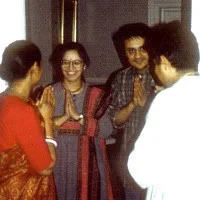 |
| ASHRAM |
Living the Four Ashrams of Life
Planning life in four stages: In the ancient Indian tradition, one planned the years of life in four ashrams or stages, with the style of Yoga practiced in each stage chosen to match the circumstances of that stage. A life of 84+ years was sought, with each of the four stages being 21 years. Some have revised these into four stages of 25 years, seeking a life of 100+ years. The purpose for this life planning is to attain the direct experience of Self-realization, Yoga or enlightenment here, in this world, in this very life. While our lifestyles may have changed since then, the basic idea of these four stages is as sound today as it was then.
| Age: | Ashram or Stage: |
| 0-21 (0-25) |
Brahmacharya/Student: The celibate student time of youth is for learning the foundation of lifestyle. The focus is on healthy, positive training and discipline, learning about spiritual, community, and family life.
|
| 21-42 (25-50) |
Grahasta/Householder: The householder phase of life is when one lives with spouse and children, fulfilling worldly interests and duties. It is a time of giving, living, learning, and loving in family and community. Religious or spiritual practices are done in the context of worldly life and service to others.
|
| 42-63 (50-75) |
Vanaprastha/Hermitage: This is a time for shifting focus more towards more inner spiritual practices of meditation, contemplation, and prayer. Relationships with grown children and community are more in the role of a matured mentor. Lifestyle is more simplified, and the couple may retreat to a quieter place for deeper practices.
|
| 63-84+ (75-100+) |
Sanyasa/Renunciate: The elder person now retreats from active involvement in all worldly goals, seeking only spiritual goals in this final phase. No longer having political, professional, or social engagements, there is a further shift towards being an elder teacher of spiritual knowledge.
|
This applies to all of us: While we are a diverse world of cultures, religions, philosophies, and attitudes, this simple framework of life planning has great value for all of us. Regardless of how we may have lived the stages of life that are already behind us, being aware of, and committed to the current and later stages of life can bring great comfort and clarity as we progress on the path ofSelf-realization .
Today, only a few Hindus strictly follow all these four ashrams. Nonetheless, the idea of enjoying the world in a religious and regulated manner, followed by gradual retirement remains a powerful ideal.
Each of the four ashrams has its specific duties.The main ones are listed below.
Brahmachari (Student Life)
The brahmacari-ashram, often away from the home (somewhat like a boarding school),
was primarily intended for fostering spiritual values. Memorisation and skill development were subsidiary to character formation and self-realisation. Even sons of the royal family were expected to undergo this austere and rigorous training.- To be celibate and live a simple life, free from sense pleasure and material allurement.
- To serve the guru (spiritual teacher) and collect alms for him.
- To hear, study and assimilate the Vedas.
- To develop all the appropriate qualities: humility, discipline, simplicity, purity of thought, cleanliness, soft-heartedness, and so on.
Grihasta (Household Life)
Traditionally some men remained lifelong celibates, either remaining as brahmacharis or
immediately becoming sannyasis. Others were required to marry, extending their responsibilities to include wife, children, relatives, and society in general. This ashram is the only one permitting sexual gratification.- To make money and to enjoy sensual pleasure according to ethical principles.
- To perform sacrifice and observe religious rituals.
- To protect and nourish family members (wife, children, and elders).
- To teach children spiritual values.
- To give in charity, and especially to feed holy people, the poor, and animals.
Vanaprashta (Retired Life)
 After the children have left home and settled, a man may gradually retire from family responsibilities and, with his wife, begin to focus his mind on spiritual matters. Often he goes on pilgrimage. His wife may accompany him, but all sexual relationships are forbidden. Vanaprashta literally means "forest-dweller."
After the children have left home and settled, a man may gradually retire from family responsibilities and, with his wife, begin to focus his mind on spiritual matters. Often he goes on pilgrimage. His wife may accompany him, but all sexual relationships are forbidden. Vanaprashta literally means "forest-dweller."- To generally devote more time to spiritual matters.
- To engage in austerity and penance.
- To go on pilgrimage.
Sannyasa (Renounced Llife)
This position is traditionally available only to men who exhibit the qualities of
a brahmana. The man would leave home and family and was prohibited from seeing his wife again. Considered civilly dead, he was free to wander, living a life dependent on God alone. The sannyasis are conspicuous in their saffron dress. They are often called sadhus (holy people) – although today not all are genuine!- To fully control the mind and senses, and to fix the mind on the Supreme.
- To become detached and fearless, fully dependent on God as the only protector.
- To teach and preach the importance of self-realisation and God-consciousness, especially to the householders, who often become distracted from their spiritual duties.
Meaning and Purpose
What does the system of four ashrams say about the purpose of life, according to Hindu thought?
Personal Reflection
- Do these stages resemble what happens in other societies? If so, what are the similarities? What are the differences?
- Are there any values which stand out for us, or with which we strongly agree or disagree? Why?
- How is our evaluation of these practices coloured by our own world view and our own culture and upbringing?
Related Values and Issues
- family values / renunciation
- the purpose of education
- ageism


.jpg)












